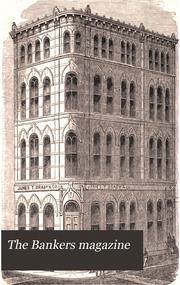
PREV ARTICLE
NEXT ARTICLE
FULL ISSUE
PREV FULL ISSUE
THE FREEDMAN'S BANKJohn Kraljevich published a great Black History Month article on the Newman Numismatic Portal February 27, 2018. It's about the Freedman's Bank, and is based on an
important history resource available in the Portal, The Banker's Magazine. Here's an excerpt. -Editor
While coins survive the centuries more or less unchanged, wealth is far less durable. Numismatists collect and study all the symbolic manifestations of wealth, but in doing so they perhaps miss the forest for the trees. The unique resources of the Newman Numismatic Portal offer abundant opportunity to study those symbols of wealth, from banking history, to paper money, to stock or share certificates, to coins made of gold and silver. Like a gravitational pull that suggests an unseen planet, these numismatic specialties can help us document the ebbs and flows of American wealth. Of course, it is easier to study the presence of something than its absence. There are no $0 banknotes or certificates issued for 0 shares of stock. Because of this, the various underclasses that have been present throughout American history — and there have been many — often seem invisible to numismatists who focus on coins and currency. Medals and tokens, and various instruments related to debt, shed precious light on those corners other specialties miss. The NNP is rich in banking history resources, many of which are hidden in plain sight: government publications that are dry reading to even the most studious among us, long runs of periodicals like The Bankers’ Magazine, whose title leaves no mystery as to what can be found within it. Aside from particularly geeky paper money enthusiasts, numismatists generally have little reason to delve in. That is, unless they’re looking for the story of the Freedman’s Bank, whose material artifacts are as scarce as the wealth of the populace the institution first set out to help. The Freedman’s Bank was incorporated as The Freedman’s Savings and Trust Company by Act of Congress on March 3, 1865. President Lincoln signed it on the final day of his first term, along with a stack of other bills passed by the previous lame-duck session of Congress. The next day, March 4, with Grant and Lee leering at each other outside the Confederate capitol of Richmond, Lincoln reminded the crowd gathered for his second inauguration that slavery “was somehow the cause of the war.” The conciliatory tone of Lincoln’s speech masked his bitterness over the struggle and the horrible cost it had exacted. Knowing that the days of the conflict were numbered, preparations had begun for the reconstruction that would follow. The Freedman’s Bank was the brainchild of private philanthropists from the Northern abolitionist community who sought to give those formerly enslaved, soldiers in particular, a safe place to deposit their wages and develop savings habits. The idea was hatched that U.S. Government backing, even a bank charter, would help the institution serve its functions better than a solely private bank ever could. Charles Sumner, the abolitionist leader from Massachusetts, introduced the bill on March 2, 1865. It passed as an afterthought, and Lincoln signed it into law the next day. By August 1869, the bank held more than a million dollars in deposits, representing the entire net worth of tens of thousands of men and women who had been enslaved just a half-decade earlier. Slowly but surely, the wages they worked so hard to earn were gathering interest, and the bank served to protect depositors from swindlers while helping to teach the basics of household economy. The reach of the Freedman’s Bank was nearly nationwide, with 24 branches established from St. Louis to Beaufort, South Carolina, from Savannah to New York. To read the complete article, see:  Wayne Homren, Editor The Numismatic Bibliomania Society is a non-profit organization promoting numismatic literature. See our web site at coinbooks.org. To submit items for publication in The E-Sylum, write to the Editor at this address: whomren@gmail.com To subscribe go to: https://my.binhost.com/lists/listinfo/esylum All Rights Reserved. NBS Home Page Contact the NBS webmaster 
|
